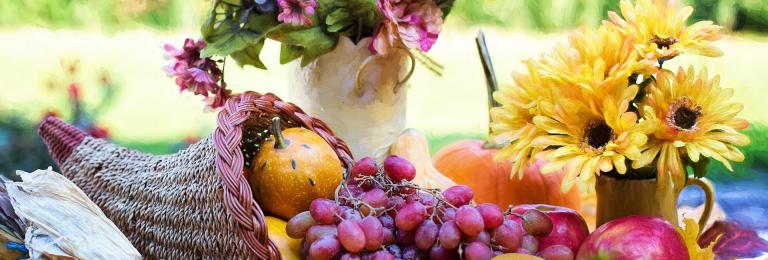Thanksgiving
Celebrating our fall harvest
Thanksgiving is not only a statutory holiday on the 2nd Monday in October in Canada, but a long-standing tradition of at least 140 years, for giving thanks and celebrating the bounty of our fall harvest with family, friends and community. Appreciate the natural flavours of our local bounty of foods and give thanks for the farmers, ranchers and other producers who keep our local food system sustainable and flourishing.
Which foods are traditionally eaten at Thanksgiving?
- Turkeys are raised all over BC and Canada. Turkeys are always free-range, meaning they’re not kept in cages like some poultry. Turkey is usually roasted and served with stuffing and gravy for Thanksgiving.
- Squash and pumpkin grow on vines and have been grown for centuries in North, Central and South America by our indigenous populations. They are rich in fibre and vitamin A and are delicious roasted and added to a variety of dishes like soups, pies, muffins, bread and rice.
- Root vegetables like potatoes, sweet potatoes and carrots are grown throughout BC and come in so many different sizes, shapes, colours and textures. They are often mashed or roasted for Thanksgiving.
- Cranberries grow abundantly in British Columbia, and are harvested in the fall. They are often turned into a cranberry sauce to accompany the Thanksgiving meal but can also be used in baking or dried and added to trail mix, cereal or salad (Note: dried fruit can be a choking hazard for children under 4 years old).
Thanksgiving activities and crafts
- Cornucopias are common decorations for this holiday, in North America, and historically at European Harvest festivals. They are also known as ‘horns of plenty’ and signify abundance and nourishment. They are horn-shaped containers filled with fruit, nuts, squash and sheaths of wheat and corn. Make a real one for decoration (don’t let children eat it!) or create one as a craft with photos or coloured paper or colouring sheets.
- Visit or create a pumpkin patch, corn maze or apple orchard. Learn what these vegetables, grains and fruits look like when they’re growing. Build children’s food literacy by talking about different parts of plants that we eat and how they grow differently, like pumpkins on vines and apples on trees.
